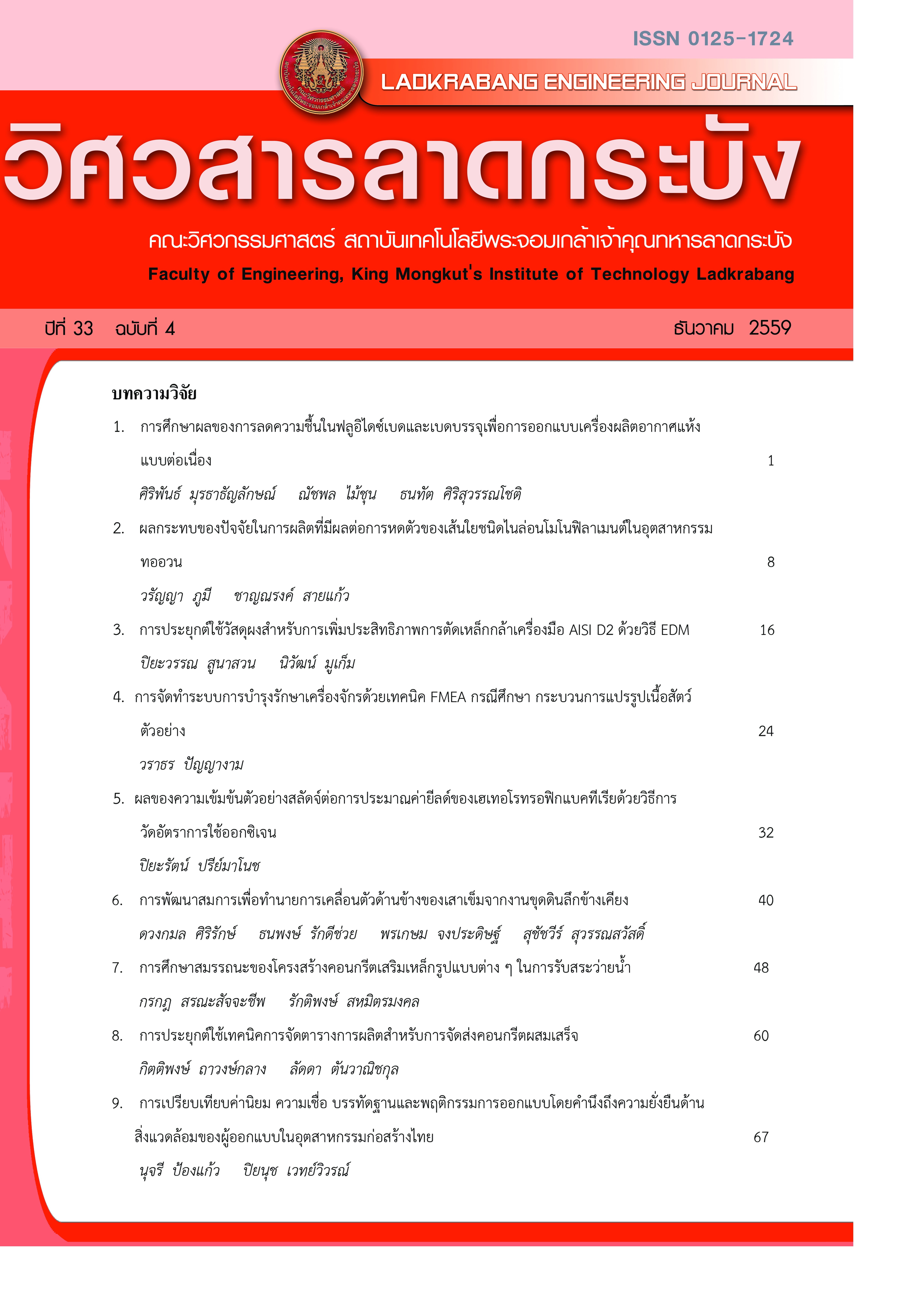ผลของความเข้มข้นตัวอย่างสลัดจ์ต่อการประมาณค่ายีลด์ ของเฮเทอโรทรอฟิกแบคทีเรียด้วยวิธีการวัดอัตราการใช้ออกซิเจน
คำสำคัญ:
แอกทิเวเต็ตสลัดจ์, ยีลด์, เฮเทอโรทรอฟิกแบคทีเรีย, อัตราการใช้ออกซิเจนบทคัดย่อ
งานวิจัยนี้มีวัตถุประสงค์เพื่อศึกษาผลของความเข้มข้นตัวอย่างสลัดจ์ต่อการประมาณค่ายีลด์ของเฮเทอโรทรอฟิกแบคทีเรียด้วยวิธีการวัดอัตราการใช้ออกซิเจนโดยใช้เครื่องวัดการหายใจอัลติเมทไฮบริด ตัวอย่างสลัดจ์นำมาจากระบบบำบัดน้ำเสียชนิดคลองวนเวียน (Oxidation Ditch) โรงพยาบาลมหาราช จ. นครราชสีมา จำนวน 2 ครั้ง ระยะเวลาห่างกัน 1 สัปดาห์ ครั้งแรกนำมาจากถังเติมอากาศความเข้มข้นเฉลี่ย 4,370 มิลลิกรัม/ลิตร และครั้งที่ 2 นำมาจากปลายท่อระบบหมุนเวียนความเข้มข้นเฉลี่ย 5,487 มิลลิกรัม/ลิตร เติมอากาศตัวอย่างสลัดจ์ทิ้งไว้อย่างน้อย 24 ชม. เพื่อไม่ให้มีสารอาหารตกค้างในน้ำและเพื่อปรับสภาพจุลินทรีย์ให้อยู่ในสภาวะการหายใจแบบเอ็นโดจีนัส การทดลองวัดอัตราการใช้ออกซิเจนแบบกะกับตัวอย่างสลัดจ์ปริมาตร 4.5 ลิตร ความเข้มข้น 880 – 5,297 มิลลิกรัม/ลิตร ด้วยสารอาหารที่ย่อยสลายง่ายซึ่งเตรียมจากสารละลายโซเดียมอะซิเตทความเข้มข้นซีโอดี (COD) อยู่ระหว่าง 7.21 - 57.05 มิลลิกรัม/ลิตร เติมให้กับตัวอย่างสลัดจ์ต่อเนื่องกันจำนวน 4 ครั้ง ควบคุม pH การทดลองเท่ากับ 7.8 ± 0.1 และอุณหภูมิ 28 ± 0.5 oC
ผลการทดลองพบว่า ความเข้มข้นของตัวอย่างสลัดจ์ไม่มีผลต่อการประมาณค่ายีลด์โดยใช้หลักการสมดุลมวลและสมการเชิงเส้นตรงบนพื้นฐานของแบบจำลองทางคณิตศาสตร์กระบวนการแอกทิเวเต็ดสลัดจ์ที่ 1 (ASM no.1) ตัวอย่างสลัดจ์จากปลายท่อระบบหมุนเวียนเจือจางมีความเข้มข้นเฉลี่ย 880, 2,186 และ 5,297 มิลลิกรัม/ลิตร มีค่ายีลด์เท่ากับ 0.63 ± 0.00 มิลลิกรัมเซลล์ (ซีโอดี)/มิลลิกรัมซีโอดี (r2 = 0.9934) ตัวอย่างสลัดจ์ที่นำมาจากถังเติมอากาศ (ความเข้มข้นเฉลี่ย 3,002 และ 4,081 มิลลิกรัม/ลิตร มีค่ายีลด์เท่ากับ 0.56 ± 0.03 มิลลิกรัมเซลล์ (ซีโอดี)/มิลลิกรัมซีโอดี(r2 = 0.9802) สลัดจ์ความเข้มข้น 880 และ 5,297 มิลลิกรัม/ลิตร ใช้เวลาวัดอัตราการใช้ออกซิเจนที่ค่าซีโอดีสูงสุด 57.05 มิลลิกรัม/ลิตร ประมาณ 80 และ 23 นาที ทั้งนี้ ค่ายีลด์ที่ได้มีค่าต่างกันเนื่องจากเปลี่ยนตำแหน่งเก็บตัวอย่างสลัดจ์และเวลาห่างกัน 1 สัปดาห์ ซึ่งถือเป็นพารามิเตอร์ที่สำคัญที่ต้องนำมาพิจารณาในการแปลผลจากการทดลอง ตามที่ได้อธิบายไว้โดย Spanjers et al. [1] โดยเฉพาะน้ำเสียจากโรงพยาบาลมีการปนเปื้อนจากยาหรือสารเคมีอื่นๆ ที่อาจจะส่งผลต่อจุลินทรีย์ในระบบบำบัดน้ำเสียในแต่ละวันได้
References
[2] Henze, M., Harremoes, P., Jansen, J. C. and Arvin, E, “Wastewater treatment: Biological and chemical processes,” (3 thed.). Berlin: Springer, 2002.
[3] Henze.M.,Grady, C.P.L.,Gujer, W., Marais, G.V.R., and Matsuo, T, “Activated Sludge model: ASM1, ASM2 andASM3” IWA Scientific and Technical Reports No.9 London: TJ International, 2000.
[4] Marsili-Libelli, S., Ratini, P., Spagni, A. and Bortone, G, “Implementation, study and calibration of a modified ASM2d for the simulation of SBR processes,” Water Sci. Technol. Vol. 43 (3), pp. 69-76, 2001.
[5] De Pauw, D. J. W. and Vanrolleghem, P. A, “Designing and performing experiments for model calibration using an automated iterative procedure,” Wat. Sci. Technol, vol. 53(1), pp. 117-127. 2006.
[6] Sin, G. and Vanrolleghem, P.A, “A nitrate biosensor-based methodology for monitoring anoxic activated sludge activity,” Water Sci Technol, vol. 50 (11), pp. 125-133, 2004.
[7] Spanjers, H. and Vanrolleghem, “Respirometry as a tool for rapid characterization of wastewater and activated sludge,” Water Sci. Technol, vol. 31 (2), pp.105-114, 1995.
[8] Vanrolleghem, P. A. and Spanjers, H, “A hybrid respirometric method for more reliable assessment of activated sludge model parameters,” Water Sci. Technol, vol. 37(12), pp. 237-246, 1998.
[9] Vanrolleghem, P. A., Spanjers, H., Petersen, B., Ginestet, P. and Takacs I, “Estimating (combinations of) Activated Sludge Model No. 1 parameters and components by respirometry,” Wat. Sci. Technol, vol. 39 (1), pp. 195-214, 1999.
[10] Ficara, E., Musumeci, A. and Rozzi, A, “Comparison and combination of titrimetric and respirometric techniques to estimate nitrification kinetics parameters,” Water SA., vol. 26 (2), pp. 217-224, 2000.
[11] Saensing, P. and Kanchanatawee, S, “Development of combined ultimate hybrid respirometer-Titrate meter to estimate kinetic parameters of activated sludge,” Suranaree J. Sci. Technol, vol. 16 (3), pp. 221-233, 2009.
[12] Premanoch, P, “Estimation of Heterotrophic bacteria coefficient yield by using oxygen uptake rate measurement,” Ramkamhaeng University journal. No.1. January-June 2015, pp. 48-59, 2015.
[13] Gapes, D. and Keller, J, “Analysis of biological wastewater treatment processes using multicomponent gas phase mass balancing,” Biotech. Bioeng, vol. 76, pp. 361-375, 2001.
[14] Metcalf and Eddy, “Wastewater Engineering: Treatment and Reuse,” (4th ed.). Botton: McGraw-Hill, 2003.
[15] American Public Health Association (APHA), “Standard Methods for the examination of water and wastewater,” (18th ed). APHa-AWWA-WEF. Washington D.C., 1995.
[16] Muller, A. W., Wentzel, M. C. and Ekama, G. A, “Experimental determination of the heterotroph anoxic yield in anoxic-aerobic activated sludge systems treating municipal wastewater,” Water SA, vol. 30(5), pp. 7-12. 2004.
[17] Dicks, K, Pind, P.f., Mosbaek, H. and Henze, M, “Yield determination by respirometry – The possible influence of storage under aerobic condition in activated sludge,” Water SA, vol. 25(1), pp. 69-74, 1999.
[18] Jeppsson, U, “Modeling aspects of wastewater treatment process. Ph. D. Thesis. Department of Industrial Electrical Engineering and Automation,” Lund Institute of Technology. Sweden [Online], Avaible:http://www.iea.lth.se/~ielulf/publications/phd-thesis/PhD-thesis.pdf,1996.
Downloads
เผยแพร่แล้ว
How to Cite
ฉบับ
บท
License
บทความที่ได้รับการตีพิมพ์เป็นลิขสิทธิ์ของคณะวิศวกรรมศาสตร์ สถาบันเทคโนโลยีพระจอมเกล้าเจ้าคุณทหารลาดกระบัง
ข้อความที่ปรากฏในบทความแต่ละเรื่องในวารสารวิชาการเล่มนี้เป็นความคิดเห็นส่วนตัวของผู้เขียนแต่ละท่านไม่เกี่ยวข้องกับสถาบันเทคโนโลยีพระจอมเกล้าเจ้าคุณทหารลาดกระบัง และคณาจารย์ท่านอื่นๆในสถาบันฯ แต่อย่างใด ความรับผิดชอบองค์ประกอบทั้งหมดของบทความแต่ละเรื่องเป็นของผู้เขียนแต่ละท่าน หากมีความผิดพลาดใดๆ ผู้เขียนแต่ละท่านจะรับผิดชอบบทความของตนเองแต่ผู้เดียว






